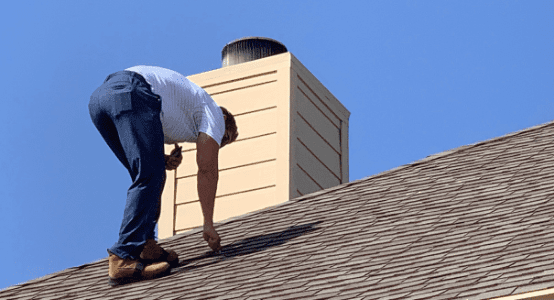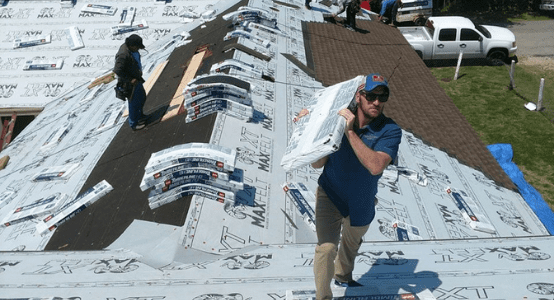Energy Efficient Roofs
Top View Roofing offers specialized reflective or “cool” roofing materials that lessen the
amount of solar radiation absorbed by your home and help to regulate indoor temperatures.
Energy efficient roofs – often referred to as cool roofs – are designed to reflect sunlight and absorb less heat than standard roofs do. These roofs can be made with reflective paint, tiles, shingles or sheet covering, and they can help you save tremendous amounts of money on your energy bills each month. In fact, many people find that installing an energy efficient roof is very cost-effective, and it may even pay for itself over time.
Energy Efficient Roofing Services
with Top View Roofing
Even if your home is insulated, the intensity of the Texas and Oklahoma heat can still penetrate the roof and dramatically increase the temperature of your attic and top floors. This will cause your air conditioning unit to overwork, thus increasing energy bills. As an alternative, Top View Roofing offers specialized reflective roofing materials that lessen the amount of solar radiation absorbed by your home and help to regulate indoor temperatures.
The biggest problem with a roof’s energy efficiency is unwanted heat. Many people believe that means a lighter colored roof is always better than a darker one – but many homes use dark-colored shingles and are still incredibly energy efficient. It turns out that the roofing materials you choose (not their color) have the biggest impact on how energy efficient your roof will be. Generally, a dark-colored ENERGY STAR-rated roof will outperform a light-colored roof that isn’t made with energy efficient materials

Energy Efficient Roofing Options
If you’re considering investing in an energy-efficient roof, certified ENERGY STAR® roofing is a must. This rating ensures that the shingle brand you select is energy-efficient and solar-reflective. Because of our partnerships with top-tier manufactures, Top View Roofing offers numerous materials that are eco-friendly and cost-effective.
Even though metal can get hot when exposed to the sun, it is highly reflective and a popular ENERGY STAR-qualified roofing material. Tile roofs are another energy-efficient material and can be made from slate, clay, concrete and other durable materials. Asphalt shingles can be very energy efficient, as well. Our team has over 25 years of roofing experience and can help you select the right option for your home!
Energy Efficient Metal Roofs
Metal roofing is one of the most energy efficient types of materials you can get – and they’re built to last, too. A metal roof can last up to 50 years with proper installation and regular maintenance. Most metal roofs are made with interlocking panels, which means they can resist wind and stormy weather, and they’re fairly light when compared to other roofing materials; that means they don’t put a significant amount of stress on roofing supports. Another great feature of energy efficient metal roofing is that it’s fireproof. You can find metal roofs in a variety of colors and styles, and on aesthetics alone, this type of roof may help increase your home’s value.
Energy Efficient Tile Roofs
Tile has long been known as an energy efficient roofing material. It makes a great insulator because air can circulate beneath the tiles, which means that these materials can help you conserve energy during all seasons.
They’re also very fire-resistant, and they’re typically strong enough to withstand inclement weather (though some tiles can crack when exposed to impact, such as large pieces of hail or flying tree branches). Depending on the type of tile you choose, your roof may last longer than 30 years – and that means over time, your roof has more of an opportunity to pay for itself.
Energy Efficient Asphalt Roofs
Asphalt shingles can be energy efficient, though not all types are. In fact, there are a few big differences between standard asphalt shingles and energy efficient asphalt shingles. Energy efficient asphalt shingles are designed with special granules that can reduce heat absorption, while their ordinary counterparts tend to absorb a significant amount of heat.
Some studies have shown that energy efficient shingles can be up to 100 degrees F cooler than ordinary shingles, which makes a tremendous amount of difference in the temperature of the home beneath them. With this protection, energy efficient asphalt shingles tend to cost a little more than their ordinary counterparts do – but they’re still more affordable than many other types of cool roofs are.
Free Roof Inspection
Regular roof maintenance can extend the lifespan of your roof and save
money on a premature replacement. As a trusted Dallas roof repair contractor,
Top View Roofing will give you peace of mind that your home is protected.
Ventilation and Energy Efficient Roofs
Although the roofing materials you choose play a huge role in how energy efficient your home is, your roof’s ventilation system is also very important. In fact, ventilation is one of the most important factors in ensuring that your roof is energy efficient.
Good ventilation allows air to circulate beneath your roofing materials and keep moisture from building up.
Letting air flow in your attic helps keep the temperatures in your home stable, whether it’s hot or cold outside. During the winter, natural air flow keeps your attic cooler and helps prevent ice dams from forming, and during the summer, vents let hot air escape so the interior of your home can stay cooler.

Common Questions About Energy Efficient Roofing
Check out these frequently asked questions about energy efficient roofing. If you don’t see the answer to your question here, please feel free to call our office and talk to an energy efficient roofing expert – that’s why we’re here.
What Type of Roof is Most Energy Efficient?
Some roofing materials are more energy efficient than others are, and every home is different. However, as a general rule, metal roofs can be designed to be among the most energy efficient available. Likewise, tile – made from slate, clay or concrete – can be very energy efficient.
How Do I Know if My Roof is Already Energy Efficient?
If your roof was installed recently and you still have your paperwork, you may be able to determine whether it’s already energy efficient.
However, if your roof is made from standard asphalt tiles and was installed several years ago, there’s a good chance that it’s not energy efficient. You can call our office and get a free roof inspection to have one of our experts check for you, as well.
What Color Roof is the Coolest?
Light colors tend to absorb less heat, so it makes sense to believe that they’re the coolest roofs. However, studies have shown that the types of materials you choose are far more important for “coolness” than the color is.
Does a Dark Roof Make Your House Hotter?
A dark-colored roof can make your house hotter inside, but there are so many factors at play in the way a roof helps your home regulate temperature that color isn’t a good measure to use. In fact, the materials your roof is made from have a much larger impact on how hot your home gets inside – and so does your roof ventilation system.
A dark roof made from energy efficient, cool materials and outfitted with a proper ventilation system will outperform a light-colored roof made from standard materials every time, keeping your home cooler in the summer and warmer in the winter.
Which Roof is Best for Texas and Oklahoma Homes?
Energy efficient roofs are the best types for Texas and Oklahoma homes. Because we experience all four seasons, as well as pretty big temperature fluctuations, it’s essential that you choose an energy efficient roof to keep your energy costs down.
Does a New Roof Help Energy Efficiency?
A new roof that’s been properly installed – provided that you choose energy efficient materials – can help improve your whole house’s energy efficiency. Older roofs weren’t always designed with energy efficiency in mind, so that, coupled with the fact that roofing materials naturally degrade over time, means that a new roof will almost certainly be more energy efficient than an old one will.
How Much Energy Can a New Roof Save?
Studies by the Environmental Protection Agency have shown that a new, energy efficient roof can lower an average home’s energy bill by up to 10 percent each month.
When you consider the fact that heating and cooling takes up about half of a home’s total energy consumption, that’s a significant amount of money (and that’s why we often say that over time, an energy efficient roof can pay for itself).
How Do Energy Efficient Roofs Impact the Environment?
Energy efficient roofs can help you use fewer resources to heat and cool your home – but they can also help the environment in other ways, too. In fact, they tend to last longer than other roofing materials because they don’t get as hot.
They can also help reduce local air temperatures (which you may have heard described as the urban heat island effect), lower peak electricity demands, and in a roundabout way, reduce power plant emissions such as carbon dioxide, sulfur dioxide, mercury and nitrous oxides.
Get in Touch With Us!
After submitting your request, one of our qualified contractors will be on-site to perform a free inspection. Call (903) 765-6054 or fill out our online form to schedule your appointment today!
- Roofing Services
- Metal Roofing
- TPO Roofing
- Roof Inspection
- Commercial Roofing
- Roof Replacement
- Residential Roofing
- Asphalt Roofing
- Tile Roofing
- Roof Coping
- Roof Leak Detection
- PVC Roofing
- Roof Maintenance
- Industrial Roofing
- Energy Efficient Roofing
- Roof Waterproofing
Free Roof Inspection
Ready to make an eco-friendly investment that will save you money on energy costs? Call the energy-efficient roofing specialists at Top View Roofing. We’ll help you make the most of your new roof with cool roofing options and coatings.
Let us help
Top View Roofing would be happy to answer all your questions and provide you with a free estimate tailored for your building. |Use our confidential Contact Form.
